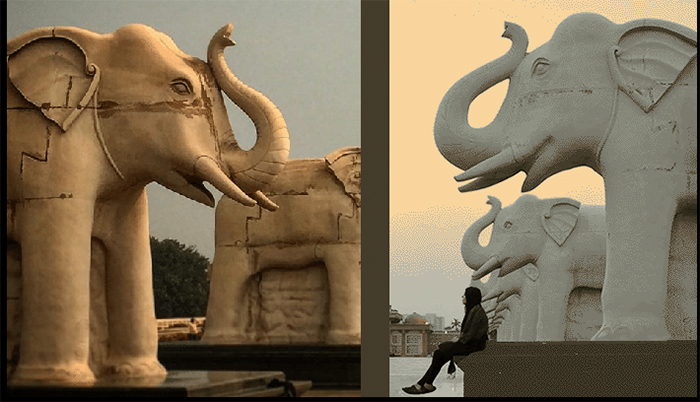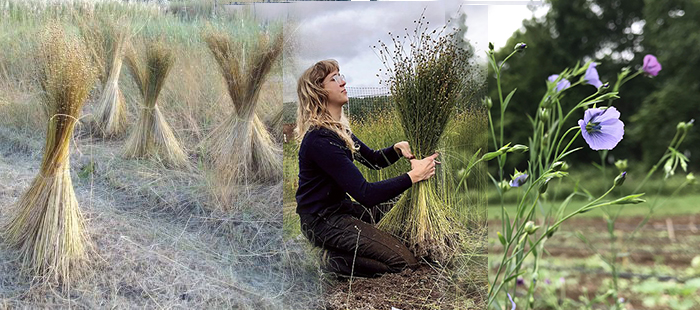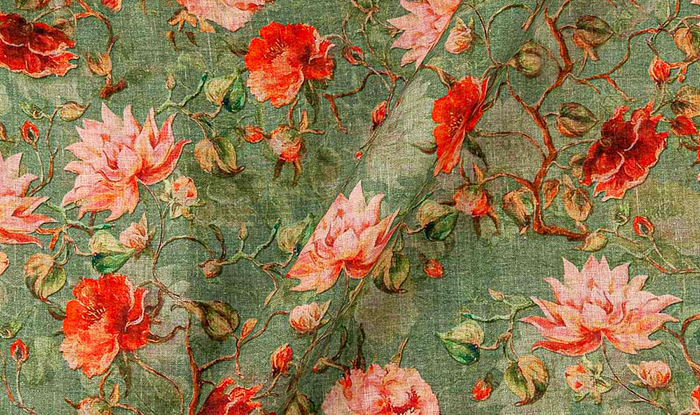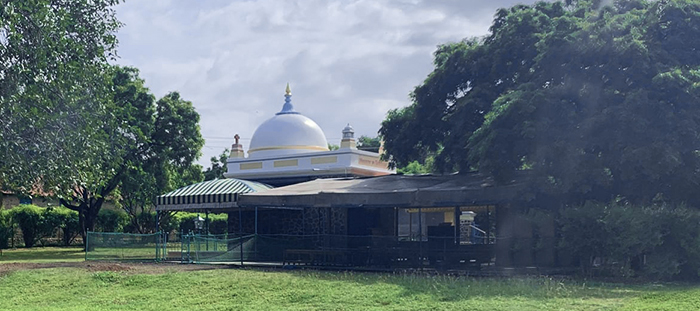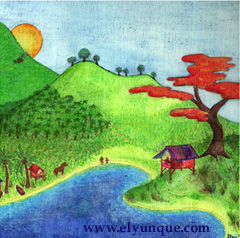CHIKANKARI . LINEN
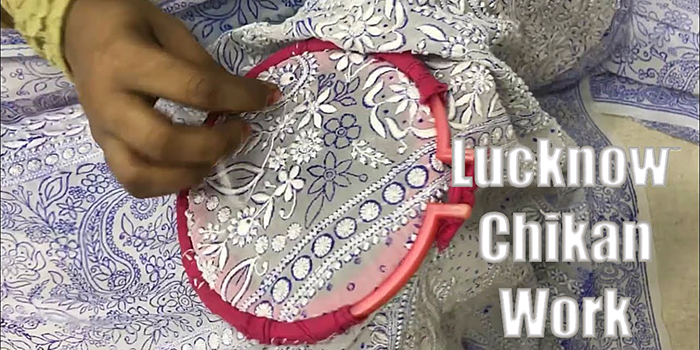 |
-------------------------------------- -------------------------------------- Lucknow Chikankari There are 5000 families involved in Chikankari embroidery in and around villages of Lucknow. The artisans belong to local Muslim communities. Nearly 90% of Chikankari work is done by women. Noor Jahan, the wife of Mughal emperor Jahangir, introduced the Persian art in India in the 17th century. Traditional embroidery work is done with white cotton thread on fine white cotton material. Now can be found on a larger range of fabrics that include chiffon, muslin, silk, organza, net, cotton. Chikankari has six basic stitches and over thirty-five other traditional stitches used in various combinations based on what the pattern to be embroidered requires. The embroidery itself is divided among the artisans, with pairs or groups of three or more specializing in one particular stitch. When one group completes their particular stitch for a garment, it is passed on to the next group to add their specialty stitch. One group may also have mastery of two or more stitches. SEWA: The Self-Employed Women's Association (SEWA) is an NGO started back in 1981 that has been nominated for the Nobel Peace Prize. UNICEF and a Literacy House report, revealed how women and children working in the chikan industry were being exploited by middlemen. SEWA was founded to create a sustainable production system for them, with direct access to markets. The chikan store run by SEWA Lucknow is located in Halwasiya Market, near Habibullah Estate. You can also go to their factory outlet, which is located in Brahm Nagar. All other stores, which go by similar names, are not an enterprise of the SEWA. Exceptional work is on display in the Crafts Museum of Uttar Pradesh. First, the fabric is cut according to requirement. Then it is block printed with design motifs on which the embroidery is done. The cloth is then washed several times and finally is ready to use. See if the chikankari on your cloth is by machine or not. If it is handcrafted, the cloth will have French knots, shadow stitch, criss cross embroidery, while in the machine made ones, you do not find these embroideries. Chikankari embroidery is the specialty in Lucknow and is unique. Vani Anand's Designer Boutique. Bhairavi's Chikan. Ada Chikan Designer Studio. Nazrana Chikan. Seva Chikan. Spirit by Raghav, are a few upscale ones.
See the monuments of Lucknow: https://www.fabhotels.com/blog/historical-places-in-lucknow/ In the city center: an elegant high-rise, full service hotel: The Renaissance. There are many hotels near the monuments and shops. La Place Sarovar Portico, Golden Tulip, near railway station. ----------------------------------- You can take a 2 hour drive day trip to Ayodhya from Lucknow. There are no remains of any structure left in Ayodhya from the time Rama was King. Ram was the epitome of goodness and taught us how to be morally correct. If you want another day in Ayodhya there are many hotels in Faizabad close to Ayodhya. The heritage hotel Kohinoor Palace, and others. ---------------------------------- August 15, 1947, marked a turning point for the handloom weavers of India. The use of charkha by Mahatma Gandhi was a symbol of national regeneration and the subsequent focus on the weavers during the freedom movement was largely responsible for the breakthrough. With a view to raising funds for the industry and organising weavers – cooperatives, Parliament passed the Khadi and other Handloom Industries Development Act in 1953. -------------------------------------- ---------------------------------------
LINEN Recent discoveries of dyed and knotted flax fibers in a prehistoric cave in the Republic of Georgia show that the plant was already used by humans from 30,000 B.C. Linen was one of the earliest textile materials used in various ancient civilizations and has found innumerable mentions in the holy texts of Hinduism. Ancient Hindu, Buddhist and Jain scriptures reveal widespread production, use and importance of linen in the Indian subcontinent. History of linen production and use dates back to 12000 BC (Vedic age) to 1500 CE (Medieval period) in the region. Egypt mummies were wrapped with Linen. On the auspicious occasion of Rama’s proposed coronation as Prince of Ayodhya, Rama clothed himself in linen. On this occasion queen Kausalya and royal courtesans of the palace were also dressed in linen. Yellow coloured linen uttariya of Krishna is mentioned in ancient scriptures.
Fibers are procured from the flax plant, also known as linseed. Linen is known for being extremely sturdy, durable as well as highly absorbent. Linen is widely used to create a variety of garments as well as Indian ethnic attire, linen sarees and salwar kameez. A cool and refreshing fabric to wear, it is extremely versatile. Linen, like most other fabrics, can be embroidered on or printed on to create different patterns or designs. Indian Handloom dates back to the Indus valley civilization. Even in ancient times, Indian fabrics were exported to Rome, Egypt, and China. Spinning: Linen is spun in water heated to 60 C (140 F). This facilitates a smooth separation of the fibers, resulting in a fine thread and the most comfortable linen fabric. The linen is then bleached in accordance with strict environmental rules which favor peroxide, rather than chlorine-based agents. It is slightly harder to manufacture linen, when compared to other fibers and fabrics. Linen is a fiber obtained from the inner section of the bark of the flax plant which is why it has superior tensile strength. Plants can be harvested by hand. The stalk is cut close to the roots. The fibers are then pulled away from the stalk and further processed. https://www.youtube.com/watch?v=3JKhhtoe9v4 The Making of LinenSASHA India's first self-managing artisanal fair-trade collective. Sasha (SACP) is a not-for-profit organization working with more than a hundred artisan and craft communities all over India. Sasha works with groups of disadvantaged women and marginalized producers & artisans from rural and semi-urban pockets of North-East India. Working with both linen and cotton. With Sasha, you can source ethically grown linen and with their experienced weavers in West Bengal. Bhagalpur (east of Varanasi, on the Ganges) is known as the best Linen and silk handloom producer. There are powerful traditional clusters in Bhagalpur and a more than 100-year-old Linen and silk weaving industry. In Bhagalpur there are an estimated 30,000 handicraftsmen working on some 25,000 handlooms. 'AVISHYA' says: In recent years Bhagalpur weavers have started using Linen fabric quite a lot in addition to the traditional Tussar silk. 'THE FABRIC WEAVERS' do as well. The Textile School offers in-depth study into traditional Bhagalpur Linen Fabric Weaveing and Handlooms. Kochi is the leading producer of linen and exports the fabric to well-known international brands. Linen made in Kochi, used by Armani, Marks and Spencer, GAP and Banana Republic are some of the brands. W.F.B. Baird and Company is the company manufacturing it at Kakkanad at the Cochin Special Economic Zone. The Linen club from Aditya Birla group, headquartered in Worli, Mumbai, is one of the finest linen sellers in India,though they are expensive, depending upon the quality and the purpose of the fabric. Linen fabric is more expensive than cotton because of its process to yarn and process to fabric. Linen can be cross dyed, which is using one color for the warp yarns and another color for the weft. This results in a wide variety of color effects. The effects can be subtle, as when adjacent colors or dramatic, as when compliments or even black/white are used. The warn is dyed prior to weaving resulting in a great color saturation. This is especially effective in making yarn dyed plaids. The different types of linen based on the weaving pattern are:
The prestigious Aditya Birla Group includes JayaShree Textiles, the parent company of the leading linen brand in India. It is the biggest integrated linen factory in the nation and has cutting-edge spinning, weaving, and finishing equipment. Kolkata based Ithika Studio states that its aim is to create fashion that is comfortable, high-quality and “good for people and the planet.” Part of its material library are handwoven cotton, linen, hemp and organic blends. The brand works with a small set of artisans and workers, ------------------------------------ INDIA - WOOL ------------------------------------- INDIA - COTTON ------------------------------------- INDIA - SILK ------------------------------------- articles and website composed by elenagh@live.com -----------------------------------------
Avatar Meher Baba Samadhi - Tomb Shrine. Meherabad The Samadhi can be visited directly from either Pune or Ahmednagar. You need to hire a car with a driver who knows how to drive to the parking up the hill, near the Samadhi. Open to everyone from 7 am to 7 pm. Information about Meher Baba: https://avatarmeherbabatrust.org/ |
VISIT INDIA --------- |
VISIT INDIA ----------- |
VISIT INDIA ---------- |
||
| • HIMALAYAN VALLEYS | ||||
|
If you want to talk about the website pages about India. please email < elenasvieques@hotmail.com >
|
